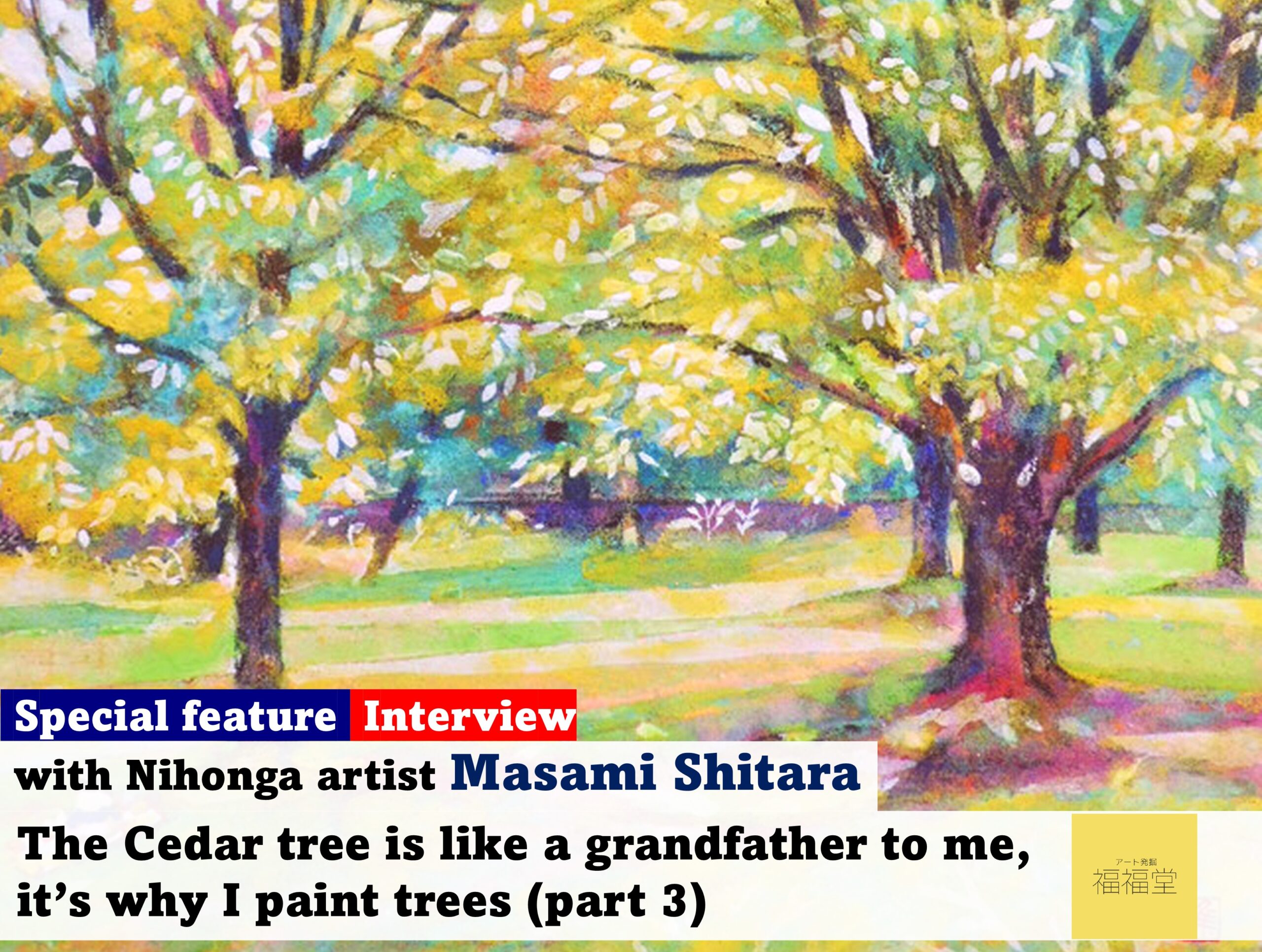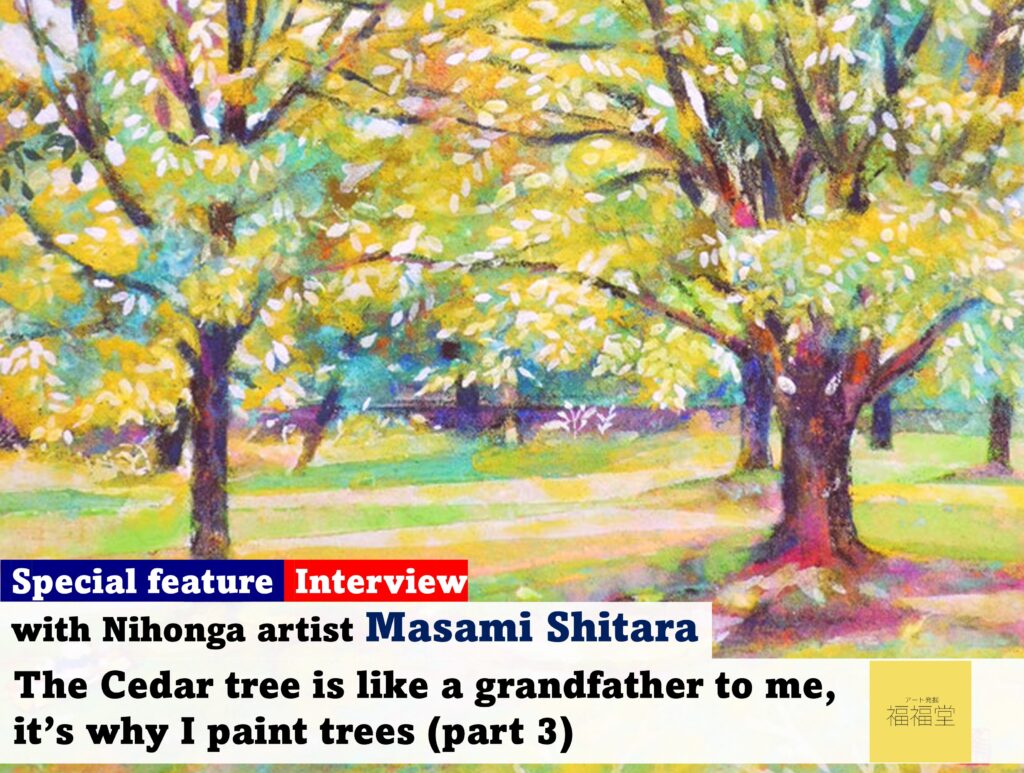
Interview with Nihonga artist, Masami Shitara. Please enjoy reading part 3 of this interview by the FFD editorial team!
Interview with Nihonga artist Masami Shitara (part 3)
Working at the bottom of the ladder
What kind of jobs did you have after you finished the charity exhibition?
Once my three-year contract at the art supply store ended, I had to look for another job. I realized that as long as I could paint on my own time, I didn’t need to be too picky about my day job. I looked for a job with a lot of time off and good pay, and decided to work at the local dentist’s office. Until then, I had been working surrounded by other artists with a common interest in painting, but this was no longer the case… I actually ended up feeling left out of the world of painting, so I ended up quitting after one year. It was difficult to make a living from painting after that, and I ended up spending more time working to earn a living rather than painting. When I was 28, I decided to become an artisan so that I could at least be involved in making things.
I see.
I worked hard and finally found a job as a jewelry stonemason. I went in with a romantic view of the job but came out disillusioned when they used a stopwatch to time me on how long I took to set the gems.
They use a stopwatch?
Yes, it was all about efficiency and how to produce quality items in the shortest amount of time, like having to run down a flight of stairs and hallway to get from one process to the other. The job required us to be physically fit in order to meet the deadline. They would get mad at us if we were taking too much time.
That sounds like a tough environment to work in.
It wasn’t at all what I’d imagined, but it taught me the importance of time management and the harsh reality of society. I can look back on it now and am grateful to those who educated me on the importance of these things and for fostering grit, but it was extremely physically demanding. Christmas was a busy season, and I didn’t take a single day off for a month and worked until the last train every single day. I became an artisan, but found I had no free time to paint, even though the very reason I chose this path was to stay connected to the art world.
Did you paint or hold exhibitions during this time?
I continued to show my paintings in group exhibitions, but just once every two years. The exhibitions were organized by a collector who had bought my first painting at a solo exhibition. Every two years, they organized a “collector’s exhibition” of painters.
What a kind and supportive collector.
As an artisan, I felt joy in “making things”, so despite the demanding workload, I found myself staying at the company for five years. I began to wonder why I’d moved to Tokyo and wondered if I would begrudge myself if I never became a painter. That helped me to make up my mind to quit that job. Sadly, once I quit the job, I realized that I was at a loss as to where to start, as I’d spent the last five years not painting much and had lost touch with the people at the gallery who’d helped me in my 20s. I even thought about quitting painting altogether.
You were at a crossroad, not knowing which way to go.

Collector’s exhibition, a turning point
The month after I quit my artisan job coincided with the “Collector’s exhibition”. The collector introduced me to an artist and fellow painter, Yumika Wakana. When I heard her story, I found a lot of similarities with my own circumstances. She suggested “If you’re thinking of quitting painting, you should join the art management course I’m currently enrolled in (GUAMS, a training course for professional painters organized by Fukufukudo and taught by painter and art producer Go Yokura)”. That’s how I came to meet people at Fukufukudo.
What happened afterwards?
I began to attend the art management course and continued my studies there. Later, I had an opportunity to present my own work, and was approached by a producer to participate in a special exhibition at a department store. My first exhibition was in December 2019 at the Fukuya Hatchobori Main Building in Hiroshima. The 20-something year old me couldn’t have imagined a future where I was holding a special exhibition gallery in a department store, and it made me really happy and grateful.

Taking an active role in department store gallery exhibitions
I felt such joy from being in the exhibition and made a commitment to myself to “become a successful painter, even though I’m not as young as I used to be”.
You’re now holding exhibitions in department store galleries nationwide!
I’ve been offered opportunities to exhibit my work in the Kanto region as well as Hokuriku to Kyushu. I’ll continue to do my very best!
Thank you again for your time today.
(FFD editorial team)
The process of creating a painting from start to finish
Interview with Nihonga artist, Masami Shitara
Nihonga painting is often associated with the use of unique paints and materials. In this interview with Nihonga painter Masami Shitara, we learn about the process of completing a painting from start to finish.

Finding a subject
The first step is to look for places or things in nature to model for my paintings, and I usually find them when taking walks. I take walks with my nieces to nearby parks where I find inspiration. When I can’t go back to my hometown in Yamagata, I can find nature in Saitama.
My nieces are three little girls; a 6 year old and twin 2 year olds. When I go on walks with them, we’re looking at flowers from a child’s point of view. I think it’s wonderful to discover things from their vantage point, because we don’t otherwise squat down to their level. Getting down to their level brings back my childhood, I can smell the soil and feel young again.
Research and Sketches
When you find a good subject, you can then start sketching. If you don’t have time, you can take pictures.

Making a draft in my studio at home
The next step is taking it home to make a rough sketch. Then, I transfer the sketch to make the drawing and start painting.

Nihonga is painted on a surface laid flat
I usually start painting in my home studio. Nihonga paint is runnier than oils, so works like this have to be painted lying flat to avoid dripping before drying.
The undercoat
Nature is a recurring theme in my paintings , and I often use a bluish-green color as my first coat. I like to mix blue mud-pigment with Gofun (white pigment) to adjust the coloring.
I think this method works best to illustrate the depth of nature’s green and the blue of the sky, while at the same time allowing viewers to see through many layers of Nihonga paint.

I’ve tried using a complimentary color like orange as the undercoat, but it ended up murky ? although that could have been because I wasn’t used to using that color. Either way, using blue felt the most natural to me.
Using mineral pigments to paint Nihonga
In Nihonga paint, the expression of the color you create depends on the size, layering, combination, amount, temperature, and humidity of the pigment particle. This is something I have yet to fully grasp, and I’m still working on how to handle and master these colors. Sometimes, I serendipitously stumble upon a tone by chance and I treasure those colors too.
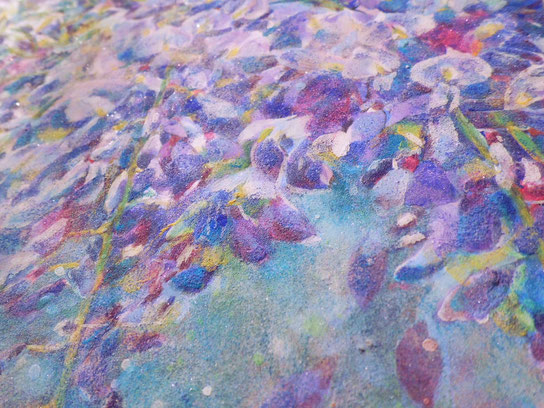
A flop can turn into a hit with the wash method
When things don’t go as you hoped, you can use the ‘wash’ method to erase the colors. Washing refers to the method of using water to thin out the color of the painted surface. The water helps other colors mix together and lift the color, so that just a portion of the paint remains in the original area.
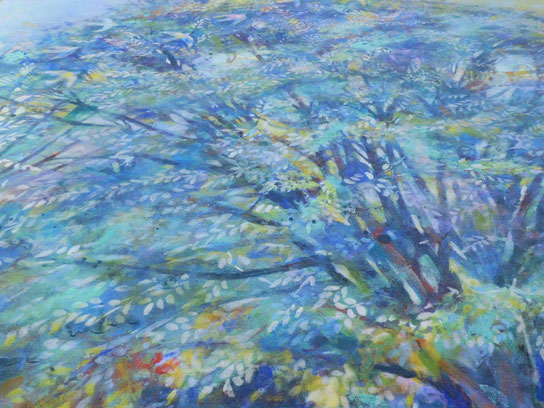
Trying various types of washi to choose one that best suits you
Repeated use of the ‘wash’ method on regular washi will result in the paper quickly disintegrating. Instead, I use Kochi hemp paper, a special type of thick washi produced in Kochi. This washi goes well with my painting style, and I really enjoy using it.
Some people with a delicate Nihonga style may find this washi too thick and stiff, but it works for me because I apply the ‘wash’ method repeatedly.
Creating Matiere (surface texture)
Matiere (surface texture) is a necessary element to convey the painter’s view. I personally prefer a rough surface, so I paint a layer of mixed gofun and coarse crystal powder on the washi then transfer the drawing on it.
After that, I use sumi ink and layers of additional Nihonga paint, starting with fine-grained paints and gradually moving onto coarse-grained paints. That said, if you can express the image without having to rely on layering, that’s fine too. I’ve been painting Nihonga for a long time, but I’m still learning new ways and techniques, and knowing that there’s more to learn is part of the fun.
If the pigment is coarse, the washi texture will appear to sparkle in the light. My subjects are usually things in nature, and I use the coarse pigment to portray the radiance of the sun shimmering.
(Interview by FFD editorial team)
A day in the life of an artist, Masami Shitara
What does the daily life of a painter look like? We asked a Nihonga artist, Masami Shitara, about a day in the life of a painter. Let’s dive in.
7:45 Wake up
I used to be a night person, but recently transitioned to a more regular schedule to maintain a healthy lifestyle. After waking up at 7:45, I enjoy a cup of coffee while watching the news.
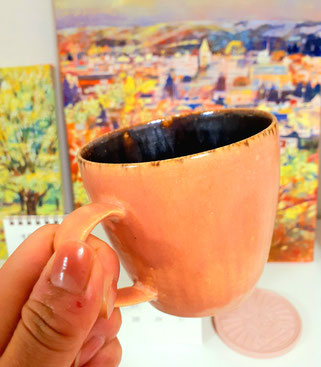
9:30 Start working on my paintings
12:30 Lunch
13:30 Work on my paintings again.
In the afternoon, I sometimes go see other artists’ paintings. I might go to a gallery or an art museum. My hobby is also painting related. Relaxing in the museum garden or at a cafe is also one of my favorite pastimes.
16:00 Go for a walk to get some physical exercise.

19:00 Dinner
21:00 Work on my paintings
22:00 Take care of various daily things
24:00 Go to sleep
Artist Masami Shitara’s bio, awards, and exhibition
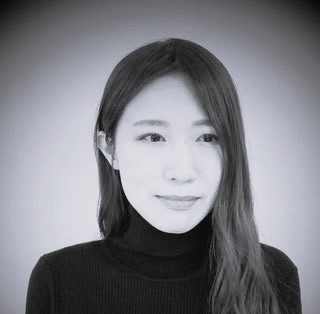
Masami Shitara
1984 Born in Tendo, Yamagata
2009 Completed Nihonga Research Field, Tohoku University of Art & Design, Graduate School of Culture and the Arts
2012
Group exhibition, Hokuto Shichisei (The Big Dipper) Exhibition, Art Space Rashinban, Tokyo
Trio exhibition, Ashita eno Tegami (Letters for tomorrow) Touring Exhibition, Gallery re:tail, Tokyo, To-o-no Kura-no-michi Gallery, Iwate (May), Build Space, Miyagi (June)
Group exhibition, Tobi-no-kai, Sato Art Museum, Tokyo
2015
Group Exhibition Tobi-no-kai, Inoue Gallery, KAMIYA-ART, Tokyo
2019
Participated in “Artists Living Here and Now 2019”, Gallery Echo-ann, Tokyo (2013, 2015, 2017)
Group exhibition, Art Sekigahara, Fukuya Hatchobori Main Building, Hiroshima
2020
Group exhibition, Neo-Naive group exhibition, Hanshin Umeda Main Building, Osaka
EGC Exhibition, Hanshin Umeda Main Building, Osaka
2021
EGC Select Exhibition, Hanshin Umeda Main Building, Osaka
EGC Exhibition, Fukuya Hatchobori Main Building, Hiroshima
Grand EGC Exhibition, Hilltopia Art Square, Tokyo
Duo Exhibition “Masami Shitara and Ayaka Matsuo – Young Artists Exhibition ~ Hikari, Komorebi and Shizuku~”, Fukuya Hatchobori Main Building, Hiroshima
2022
EGC Exhibition, Fukuya Hatchobori Main Building, Hiroshima
Grand EGC Exhibition, Hanshin Umeda Main Building, Osaka
2010
Solo Exhibition Masami Shitara Exhibition, Ginza Yuu Gallery, Tokyo
2011
Solo Exhibition Masami Shitara Exhibition, Ginza O Gallery UP-S, Tokyo
2013
Solo Exhibition Masami Shitara Exhibition, Etsuko Shibata Gallery, Tokyo
2022
Solo Exhibition Masami Shitara Nihonga Exhibition ~Kigi no Sazameki (The Rustle of the Trees)~, Yamaguchi Izutsuya, Yamaguchi
Solo Exhibition Masami Shitara Nihonga Exhibition ~Kaze no Sazameki (The Rustle of the Wind)~, Kokura Izutsuya, Fukuoka
2006
The 33rd Soga Exhibition, Honorable Mention, exhibited at the Tokyo Metropolitan Art Museum, Tokyo, (Honorable Mention in 2007, 2011)
2008
The 34th Spring Soga Exhibition, Honorable Mention, exhibited at the Nihonbashi Takashimaya Department Store, Tokyo, (Honorable Mention in 2010)
The 26th The Ueno Royal Museum, Grand Prize Exhibition, The Ueno Royal Museum, Tokyo
Description of Masami Shitara’s work
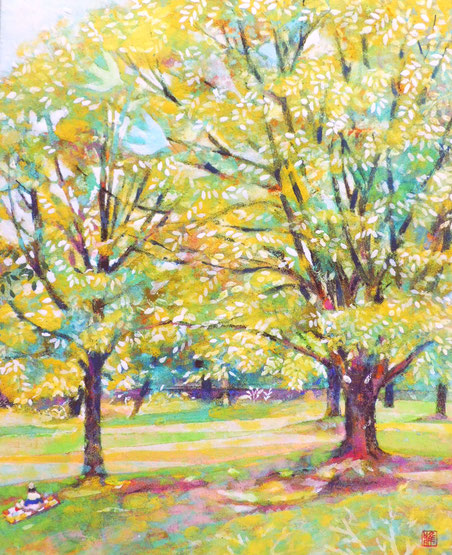
Under a clear autumn sky, the yellow leaves of a zelkova tree shine in the breeze. This painting immediately transports us back to a clear autumn day. We see someone lounging in the sun under the tree, and a red water bottle on a yellow blanket. The props illustrate a cozy, gentle autumn scene.
During the COVID-19 pandemic, the artist was unable to return to her home in the rugged nature of Yamagata Prefecture, where she was raised. At that time, while visiting a park with her niece in Saitama, she felt so moved by the peaceful zelkova trees that exuded a sense of human activity. The work conveys these deep emotions felt by the artist.
(FFD)
Details of Masami Shitara’s exhibition
Masami Shitara: Japanese Painting Solo Exhibition
2025.1.8-13
Venue: Yamaguchi Izutsuya 5F Art Gallery
Admission free
